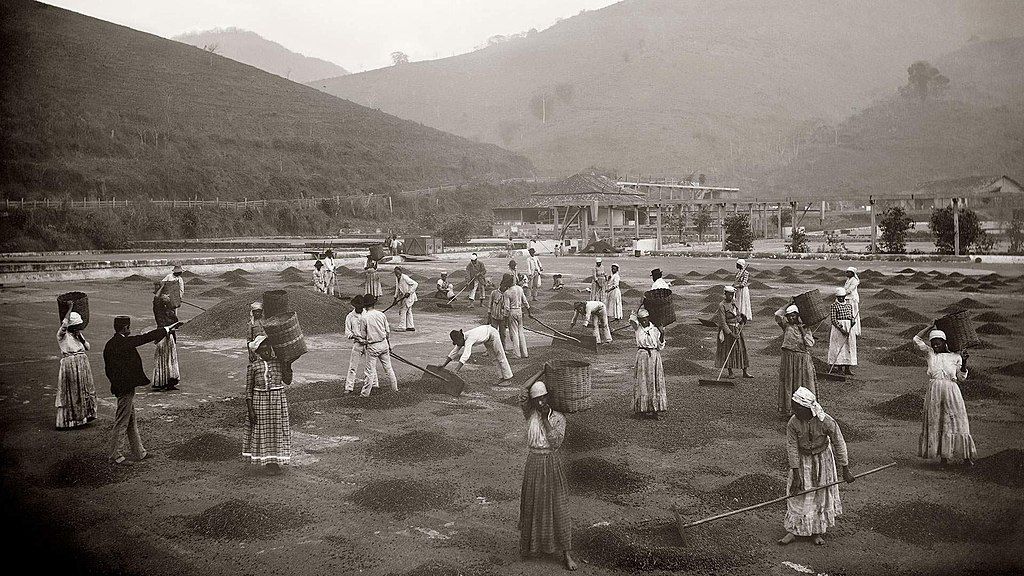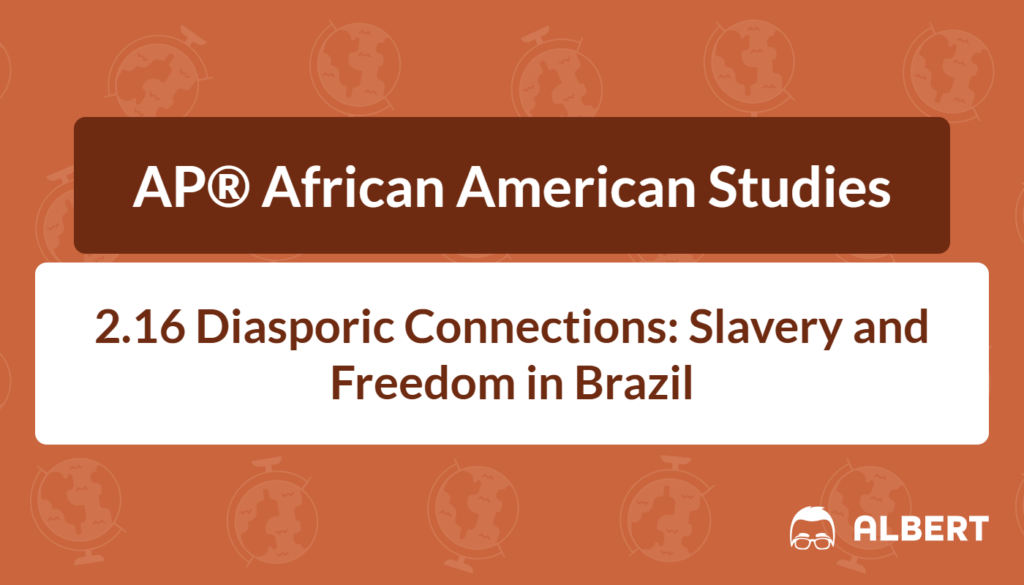What We Review
Diasporic Connections: Slavery and Freedom in Brazil
Introduction
Slavery is the practice of forcing individuals to work without pay or freedom. Diaspora refers to the movement of people away from their homelands, often carrying their cultures, beliefs, and traditions with them. These two ideas connect powerfully when studying Brazil. Brazil had the highest number of enslaved Africans in the Americas, shaping its culture, social structure, and economy.
Studying slavery in Brazil is important for understanding the broader African diaspora. It shows how African traditions, languages, and customs spread and survived despite harsh conditions. This post focuses on why so many Africans were brought to Brazil, how they lived and worked, and what happened when slavery ended. These details connect to AP® African American Studies standards, specifically LO 2.16.A and LO 2.16.B, which explain features of enslavement in Brazil and shifts in enslaved populations over time.
The Enslavement of Africans in Brazil
The Scale of Enslavement
More enslaved Africans disembarked in Brazil than in any other country in the Americas (EK 2.16.A.1). Experts estimate that about half of the 10 million Africans who survived the Middle Passage landed in Brazil. By comparison, fewer Africans were taken to other destinations, such as the British colonies in North America.
This massive influx happened because Brazil’s large plantations and mines needed constant labor. Sugar plantations, gold mines, and other major industries demanded workers who could be forced to work long hours. Moreover, Brazil’s extensive coastline made it easier for slave ships to dock at multiple ports, creating diverse entry points for the large numbers of enslaved Africans.
The Journey: The Middle Passage
The Middle Passage was the voyage across the Atlantic Ocean that forcibly brought Africans to the Americas. Conditions on these ships were brutal. Enslaved individuals were packed into tight spaces, given little food or water, and exposed to disease. As a result, many did not survive the trip. Those who arrived faced immediate sale and transportation to labor sites, often far from the coast. Consequently, the trauma of this journey shaped African communities in Brazil, leading them to develop coping strategies and preserve essential cultural practices.
Life and Labor of Enslaved Africans in Brazil
Areas of Labor
Enslaved Africans worked in various sectors in Brazil (EK 2.16.A.1). The major industries included:
- Sugar plantations: Known for producing large amounts of sugar that fueled European demand.
- Gold mines: Key sites in areas such as Minas Gerais, providing wealth to the colony.
- Coffee plantations: Brazil eventually became a top coffee producer.
- Cattle ranching: Large ranches required enslaved labor to herd cattle and manage land.
- Production of food and textiles: Enslaved people cultivated crops and made textiles for local and global markets.
Sugar plantations, in particular, were notorious for harsh working conditions. Workers labored under the hot sun, cut sugarcane by hand, and processed it in dangerous sugar mills. Indeed, the constant push for profit often led to severe punishment and limited life expectancy for enslaved workers.

Cultural Preservation and Expression
Despite these hardships, African communities in Brazil maintained important aspects of their heritage (EK 2.16.A.2). Through shared language, music, and religious beliefs, they helped each other stay connected to African roots. For instance, some enslaved Africans practiced capoeira, a martial art that blended fighting techniques, music, and dance. Capoeira was often disguised as dance to avoid punishment from plantation owners.
Another example is the congada, a celebration that honors the king of Kongo and Our Lady of the Rosary. These traditions have survived and remain part of Brazil’s cultural fabric. They serve as symbols of resistance, identity, and heritage, showing how enslaved Africans preserved their dignity even under oppressive conditions.
Shifts in the Numbers of Enslaved Africans
The Nineteenth Century Dynamics
During the nineteenth century, Brazil experienced significant changes in its enslaved population. The number of enslaved Africans steadily decreased, while the number of free Black people continued to rise (LO 2.16.B). This occurred because of the growing practice of manumission, which is the act of freeing an enslaved person.
In contrast, in the United States, the enslaved population continued to grow throughout the same period (EK 2.16.B.2). Even though the U.S. banned the importation of enslaved Africans in 1808, children born to enslaved mothers were also enslaved. Therefore, the total enslaved population in the United States reached about 4 million by the time of the Emancipation Proclamation.
The Role of Manumission
Manumission in Brazil was influenced by Iberian laws and the Catholic Church (EK 2.16.B.1). Sometimes, enslaved individuals were allowed to earn wages and purchase their own freedom. Others gained freedom through the goodwill of certain slaveholders or by church support. As a result, by 1888, when Brazil finally abolished slavery, around 4 million people of African ancestry were already free. This meant that about 1.5 million people were still enslaved at that time.
These dynamics shaped Brazil’s society. A large population of free Black Brazilians lived alongside those who remained enslaved. This also influenced community organization and local economies, as free Black communities developed their own networks and sought to protect the rights of newly freed people.
Abolition of Slavery in Brazil
Historical Context
Many wonder, “When did Brazil abolish slavery?” and the answer is central to understanding Brazil’s social history. Brazil and slavery were strongly connected for centuries, but public pressure and changing international attitudes led to new laws. The road to freedom was slow. Several laws, such as the Law of the Free Womb (1871), began to undermine the institution of slavery. This law declared that children born of enslaved mothers would be free after they turned a certain age.
Finally, in 1888, Princess Isabel signed the Golden Law, also known as the Lei Áurea, which ended legal slavery in Brazil. At that moment, Brazil became the last country in the Americas to abolish slavery. However, the journey to equality was far from complete.
Significance of Abolition
Abolition changed Brazil’s workforce, population makeup, and social order in dramatic ways. The newly freed population needed jobs and homes. Unfortunately, many faced discrimination and limited opportunities. Landowners still held much control, and formerly enslaved people often became “free” laborers, still working on plantations under tough conditions.
It is estimated that nearly 1.5 million people were set free by the Golden Law, adding to the millions who had already gained their freedom through manumission. These freed individuals formed new communities, organized labor, and continued to preserve African customs. They influenced music, dance, religion, and food traditions that remain important parts of Brazil’s cultural heritage.
Conclusion
Slavery in Brazil is a profound chapter in the history of the African diaspora. From the high number of arrivals to the enduring cultural traditions, enslaved Africans shaped the evolution of Brazil’s society. Their labor drove major industries like sugar and coffee, while their resilience ensured that African traditions, such as capoeira, survived to the present day.
The transition from enslavement to freedom was long and difficult, involving manumission, church influence, and slow-moving reforms. When Brazil abolished slavery in 1888, it marked a key milestone that ended centuries of legal enslavement. Yet the legacy of this institution continues to influence social structures and cultural identities throughout the nation. Recognizing this heritage is essential for understanding modern Brazil and the global African diaspora.
Key Historical Sources and Their Significance
1. Festival of Our Lady of the Rosary, Rio de Janeiro, Brazil, by Carlos Juliao (circa 1770s)
- This artwork depicts a celebration connecting the Catholic faith with African traditions. It shows the importance of religious gatherings in preserving culture and honoring both African heritage and Catholic saints. Events like these helped enslaved Africans form inclusive communities that celebrated identity and spiritual beliefs.
2. Escravo Mina and Escrava Mina, by José Christiano de Freitas Henriques Junior (1864)
- These images portray enslaved individuals from the Mina region of West Africa. They highlight the diverse ethnic backgrounds of Africans in Brazil and offer a window into daily life and attire. Such visual records remind viewers of the human story behind labor and cultural exchange.
Vocabulary Reference Chart
| Term | Definition |
| Slavery | A system where people are treated as property and forced to work without pay or freedom. |
| Diaspora | The scattering of people from their original homeland to various regions around the world. |
| Middle Passage | The journey across the Atlantic Ocean in which Africans were transported to the Americas. |
| Manumission | The act of granting freedom to enslaved individuals. |
| Golden Law (1888) | The Brazilian law that completely abolished slavery in the country. |
| Capoeira | A martial art combining dance, music, and sparring, developed by enslaved Africans. |
| Congada | A celebration honoring the king of Kongo and Our Lady of the Rosary, reflecting Afro-Brazilian devotion. |
| Iberian Laws | Legal frameworks influenced by Portugal and Spain, affecting manumission practices in Brazil. |
Understanding the depth and impact of slavery in Brazil helps clarify how a nation’s past continues to shape its present. The story of resilience and cultural survival demonstrates the strength of African communities worldwide. By examining this history, students can grasp the broader lessons of human rights, dignity, and cultural exchange that are so important in AP® African American Studies.
Sharpen Your Skills for AP® African American Studies
Are you preparing for the AP® African American Studies test? We’ve got you covered! Try our review articles designed to help you confidently tackle real-world AP® African American Studies problems. You’ll find everything you need to succeed, from quick tips to detailed strategies. Start exploring now!
Need help preparing for your AP® African American Studies exam?
Albert has hundreds of AP® African American Studies practice questions, free response, and full-length practice tests to try out.









